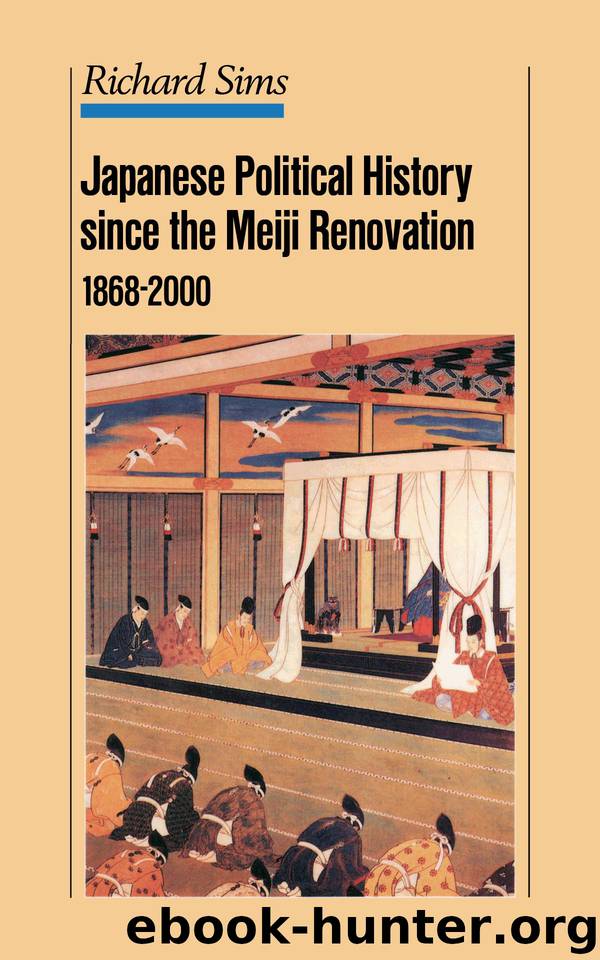Japanese Political History since the Meiji Renovation, 1868-2000 by Richard Sims

Author:Richard Sims
Language: eng
Format: epub
Tags: History, Japan, Politics
ISBN: 0-312-23914-9
Publisher: Palgrave Publishers Ltd.
Published: 2001-03-28T16:00:00+00:00
186The Saito cabinet
Lack of unity within the nationalist movement meant that, even if its general impact on the political atmosphere was great, it was unlikely to bring about a political revolution. A number of further plots to assassinate cabinet members were hatched during 1932 and 1933, but in each case the arrest of the plotters prevented their implementation. Meanwhile, with the blessing of Saionji and with differing degrees of support from the Seiyukai and the Minseito, the compromise Saito cabinet went some way towards fulfilling its mission of restoring stability. Urban unrest was reduced by a major expansion of public works schemes, and similar help was given to the villages by local governments. In 1933 a Rice Control Law extended the 1931 provision for government intervention in the market to prevent the price from falling below a fixed level. Even more important was the general revival of the economy which resulted from the devaluation of the yen, Takahashi's reflationary policy, declining interest rates, and the fuller utilisation of the production capacity which had been lying idle. Between 1931 and 1934 the number of companies in Japan leaped from 57,226 to 78,198 and the tide of unemployment receded at a faster rate than in other major countries. The Japanese spoke less often of hijoji, and the sense of crisis and foreboding which had been prevalent in 1930-1 gradually dissipated.
In the area of foreign policy, too, the Saito cabinet attuned itself to the popular mood by recognising Manchukuo as an 'independent' state in September 1932 and by terminating Japanese membership of the League of Nations in March 1933. Despite these gestures of defiance towards the international community, however, the cabinet was more interested in stabilising the international situation than embarking on new adventures. It withdrew Japanese troops from one part of north-east China after concluding the Tangku truce in May 1933, and it refused to allow itself to be pushed into a military confrontation with the Soviet Union, as some key military officers, including Army Minister Araki, wished. In a series of Five Minister (Prime, Foreign, Finance, Army and Navy) Conferences in October 1933, Foreign Minister Hirota Koki and Finance Minister Takahashi resisted Araki's demand for preparation for war with the Soviet Union by 1936, and with Saito's backing they confirmed that Japan's policy should emphasise the 187settlement of current problems by diplomatic means.
This rebuff for Araki was soon followed by another. In November and December a committee of eight ministers set up to coordinate internal policy was faced with a strong demand by Agriculture Minister Goto Fumio for increased expenditure on farming village relief measures. Goto was supported by Araki but firmly opposed by Takahashi and Railway Minister Mitsuchi, and the impasse was resolved only by re-allocating funds which had been committed to the army. While this concession did little to check the trend of steadily rising army expenditure, it further diminished Araki's standing with those headquarters staff officers who already felt that he was running too great a risk of
Download
This site does not store any files on its server. We only index and link to content provided by other sites. Please contact the content providers to delete copyright contents if any and email us, we'll remove relevant links or contents immediately.
The Vikings: Conquering England, France, and Ireland by Wernick Robert(79219)
Ali Pasha, Lion of Ioannina by Eugenia Russell & Eugenia Russell(39937)
The Vikings: Discoverers of a New World by Wernick Robert(36830)
The Conquerors (The Winning of America Series Book 3) by Eckert Allan W(36715)
Cecilia; Or, Memoirs of an Heiress — Volume 1 by Fanny Burney(32090)
Cecilia; Or, Memoirs of an Heiress — Volume 3 by Fanny Burney(31480)
Cecilia; Or, Memoirs of an Heiress — Volume 2 by Fanny Burney(31434)
Empire of the Sikhs by Patwant Singh(22779)
Hans Sturm: A Soldier's Odyssey on the Eastern Front by Gordon Williamson(18340)
The Secret History by Donna Tartt(18261)
Cat's cradle by Kurt Vonnegut(14803)
Sapiens: A Brief History of Humankind by Yuval Noah Harari(14005)
Pimp by Iceberg Slim(13826)
Talking to Strangers by Malcolm Gladwell(12912)
Norse Mythology by Gaiman Neil(12878)
Leonardo da Vinci by Walter Isaacson(12831)
Underground: A Human History of the Worlds Beneath Our Feet by Will Hunt(11857)
4 3 2 1: A Novel by Paul Auster(11840)
The Radium Girls by Kate Moore(11648)
